How to make cassasva starch?
When people plan to start a cassava starch processing plant business, they usually take care about the question how to make cassava starch, reliable technical support is very important for the cassava starch processing plant smooth working. Doing Company as a rich experience and professional cassava processing machines manufacture, in this article explain the cassava starch making process for you.
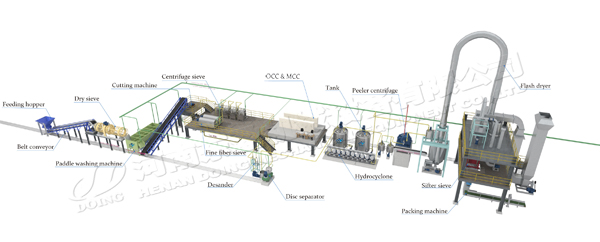 Cassava starch making process design
Cassava starch making process design
Firstly, the production principle of how to make cassava starch:
The cassava starch making process is actually a physical separation process, which separates cellulose, protein, inorganic salts and other substances in the raw materials from starch. In the production process, according to the insoluble starch and the specific gravity of the starch, the starch is separated from the water suspension by using the special effect of the machine. The production process is divided into six main sections: cleaning, crushing, separation, concentration&refinery, dewater and drying; its also divided into 11 control point: transportation, cleaning, crushing, separation, fine separation, sand removal, concentration and refining, dehydration, drying, and air cooling, packing.
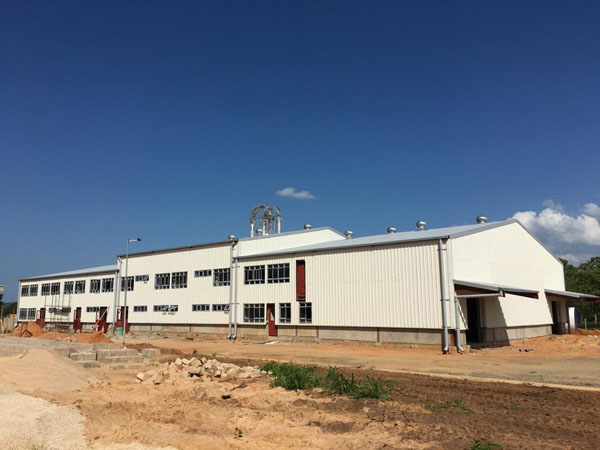 Cassava starch processing plant overview
Cassava starch processing plant overview
Following is the divided cassava starch making process introduction:
1. Cleaning:
The role of cleaning: Mainly to remove the sediment from the outer surface of the cassava, and wash away the epidermis of the cassava roots, generally used in combination with multi-stage cleaning, divided into dry cleaning and peeling and strong cleaning. Cleaning the fresh cassava or cassava chips, which are raw materials for the production of starch, is the basis for ensuring the quality of the starch. The cleaner the cleaning, the better the quality of the starch. At the same time, a portion of the hydrocyanic acid in the roots can be removed during the cleaning process.
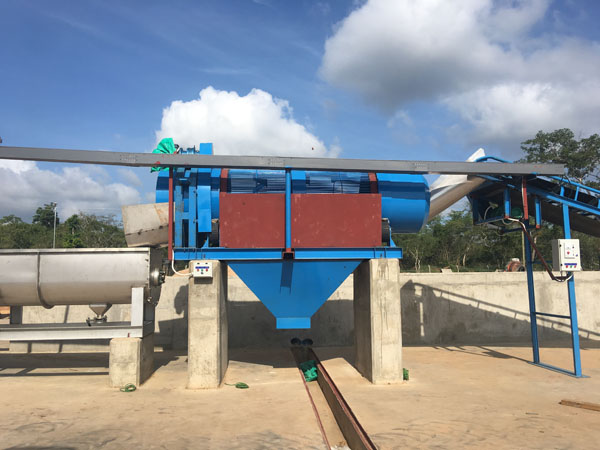
2. Crushing:
The role of crushing section: cassava starch is mainly stored in the fleshy part of the roots, only a small amount stored in the endothelium. The purpose of this crushing section is to destroy the structure of cassava, so that tiny starch granules can be separated from the roots smoothly. The starch released from the cells is called free starch; the starch remaining in the cells inside the slag is called bound starch. The purpose of the crushing is to release the free starch as much as possible.
3. Separation
The cassava slag is a slender fiber, the volume is larger than the starch granules, the expansion coefficient is also larger than the starch granules, and the specific gravity is lighter than the starch granules. The pulverized raw pulp is mixed with water as a medium, and then uniformly fed by a slurry pump. The centrifuge sieve, under the action of mechanical oscillation, rollover, centrifugation, and hydraulic flushing, repeatedly washes the starch slurry and passes through a screen of 80-120 mesh to separate the slag from the starch milk.
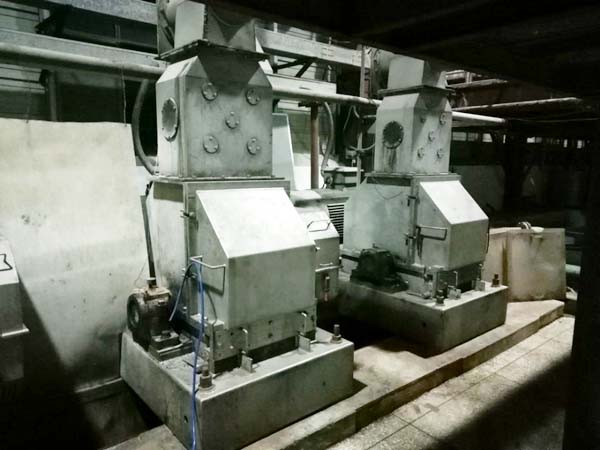 Rasper-professional cassava crusher for starch extraction
Rasper-professional cassava crusher for starch extraction
4. Concentration&refinery
The specific gravity of mud and sand is greater than that of water, and is greater than the specific gravity of starch granules. So this part for how to make cassava starch according to the principle of separation of specific gravity, the use of cyclone to remove sand can achieve better results. The specific gravity of the yellow pulp is close to water and lighter than the specific gravity of the starch granules. The shape is palm shape. The longer the processing cycle, the greater the latex performance, the sifting, sticking to the starch granules, extremely difficult to separate, the starch swirling station and The disc separator is designed according to the principle of gravity separation. The cassava starch generally needs to be separated twice to achieve better product quality. Two separations can be used for one starch swirling station or two. Stage disc centrifuge, can also use a combination of disc separator + starch hydrocyclone station.
5. Starch dewater:
The disc separator generally has a concentrated emulsion of 20 waves, need to be centrifuged again to improve the dry explosion efficiency and save energy. By the centrifugation of the high speed rotation of the scraper centrifuge, the solid phase and the liquid phase are separated, and most of the water is thrown out from the gap of the filter cloth on the screen, and the moisture content of the wet starch is less than 38%, so as to save heat. To increase the requirements of production and quality, but the scraper centrifuge is expensive and consumes a lot of energy. The modern tapioca starch factory and vacuum dewatering machine are also widely used. The vacuum dewatering machine adopts the constant pressure cake layer bridge filtration principle. When working, the speed regulating motor drives the rotating drum to rotate in the slurry tank, and the solid matter (wet starch) is Adsorbed on the filter cloth of the drum, when a certain thickness is reached, the fixed scraper scrapes off the solid matter, and the filtrate enters the steam separator to achieve the purpose of separation of starch, water and gas, and the energy consumption is one-third of that of similar equipment.
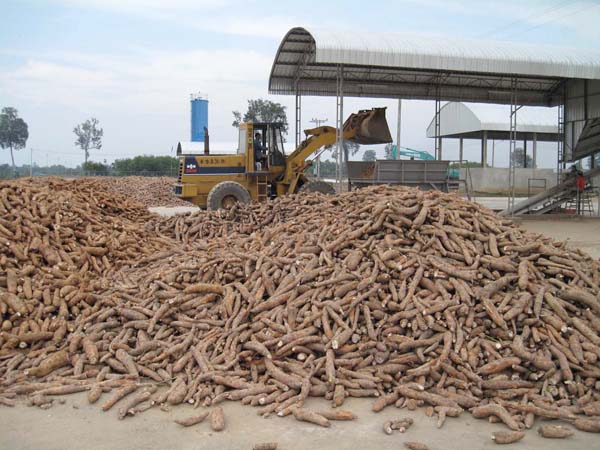 Fresh cassava transporation
Fresh cassava transporation
6. Fast drying:
At present, the starch plant generally uses flash drying equipment (also called rapid drying), and the whole process time is completed in an instant. Therefore, the internal moisture of the starch granules is less than gelatinized and dried, so that gelatinization or degradation does not occur. The airflow is a cocurrent drying process, that is, the cocurrent process of the wet material and the hot gas flow, which consists of two processes of heat transfer and mass transfer. When the wet starch is in contact with hot air, the hot air transfers the heat energy to the surface of the wet starch and then from the surface to the inside. This process is the heat transfer process; at the same time, the moisture in the wet starch is liquid or gaseous from the inside of the material. It spreads to the surface of the starch and diffuses into the air through the gas film through the surface of the starch. This is a mass transfer process. The high-temperature airflow and the wet starch are uniformly exchanged in the drying tube to make the dry starch powdery, and after cooling, it can be packed into the warehouse.
Leave a message
- WhatsApp:
+8613526615783
- Email:
sales@doinggroup.com
- Tel:
0086 135 2661 5783
- Phone:
0086 371 5677 1822
- Skype:
elina881130
- Address:
No.133 Yaozhai Road, Jinshui District, Zhengzhou City, Henan Province, China
-
 What is high quality cassava flour, how to produce high quality cassava flour ?
What is high quality cassava flour, how to produce high quality cassava flour ?
-
 Cassava starch manufacturing process
Cassava starch manufacturing process
-
 How to process cassava into cassava chips ?
How to process cassava into cassava chips ?
-
 Which kind of cassava peeling machine popular in Nigeria ?
Which kind of cassava peeling machine popular in Nigeria ?
-
 How to maintain cassava starch processing equipment ?
How to maintain cassava starch processing equipment ?
-
 How to extract cassava starch ?
How to extract cassava starch ?
-
 What is cassava flour used for?
What is cassava flour used for?
-
 How to make cassasva starch?
How to make cassasva starch?
-
 Water, electricity, steam and land deploy in starch processing plant
Water, electricity, steam and land deploy in starch processing plant
-
 How profitable is cassava starch made?
How profitable is cassava starch made?
-
 What is high quality cassava flour, how to produce high quality cassava flour ?
What is high quality cassava flour, how to produce high quality cassava flour ?
-
 How to process cassava into cassava chips ?
How to process cassava into cassava chips ?
-
 Cassava starch manufacturing process
Cassava starch manufacturing process
-
 How to maintain cassava starch processing equipment ?
How to maintain cassava starch processing equipment ?
-
 How to extract cassava starch ?
How to extract cassava starch ?
-
 How to make cassasva starch?
How to make cassasva starch?
-
 Water, electricity, steam and land deploy in starch processing plant
Water, electricity, steam and land deploy in starch processing plant
-
 How profitable is cassava starch made?
How profitable is cassava starch made?
Leave a message

Tel/Whatsapp:
+8613526615783



